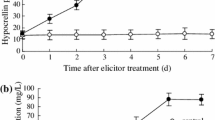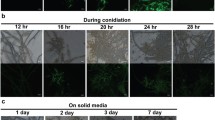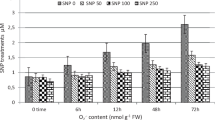Abstract
Elicitor prepared from the cell walls ofPenicillium citrinum induces multiple responses ofTaxus chinensis cells, including nitric oxide (NO) generation, sequentially followed by the activation of PAL and synthesis of taxol. NO scavenger cPITO and nitric oxide synthase (NOS) inhibitor PBITU prevent the latter two reactions, all of which are triggered in the absence of elicitor by NO donor sodium nitroprusside (SNP). The elicitor-induced NO release ofTaxus chinensis suspension cells is strongly inhibited by PBITU. These results demonstrate a causal relationship between NO generation and the latter two reactions ofTaxus chinensis cells to the elicitor, and also indicate that NO, produced via NOS inTaxus chinensis cells treated with fungal elicitor, might act as an essential signaling molecule for triggering the activation of PAL and synthesis of taxol.
Similar content being viewed by others
References
Cragg, G. M., Schepartz, S. A., Suffness, M. et al., The taxol supply crisis-new NCI policies for handling the large-scale production of novel product anticancer and anti-HIV agents, J. Nat. Prod., 1993, 56(10): 1657–1668.
Wu, J., Wang, C., Mei, X., Stimulation of taxol production and excretion in Taxus spp cell cultures by rare earth chemical lanthanum, J. Biotechnol., 2001, 85: 67–73.[DOI]
Ebel, J., Scheel, D., Elicitor recognition and signal transduction, in Genes Involved in Plant Defense (eds. Boiler, T., Meins, F.), New York: Spnnger-Verlag, 1992, 183–205.
Roberts, S. C., Shuler, M. L., Large-scale plant cell culture, Curr. Op. Biotechnol., 1997, 8: 154–159.[DOI]
Ciddi, V., Srinivasan, V., Shuler, M. L., Elicitation ofTaxus sp. cell cultures for production of taxol, Biotechnol Lett., 1995, 17: 1343–1346.
Li, C., Yuan, Y. J., Ma, Z. H. et al., Changes of physiological state of suspension cultures ofTaxus chinensis var. mairei induced by oligosaccharide, J. Chem. Indus. & Engineer (in Chinese), 2002, 53(11): 1133–1138.
Dietrich, A., Mayer, J. E., Hahlbrock, K., Fungal elicitor triggers rapid, transient, and specific protein phosphorylation in parsley cell suspension cultures, J. Biol. Chem., 1990, 265: 6360–6368.
Nürnberger, T., Colling, C., Hahlbrock, K. et al., Perception and transduction of an elicitor signal in cultured parsley cells, Biochem. Soc. Symp., 1994, 60: 173–182.
Baker, C. J., Orlandi, E. W., Active oxygen in plant pathogenesis, Annu. Rev. Phytopathol., 1995, 33: 299–321.[DOI]
Guan, Y. Y., Lin, M. J., The role of NO in human immunity system, New Medicine, 1999, 30(1): 55–57.
Guo, F. Q., Okamoto, M., Crawford, N. M., Identification of a plant nitric oxide synthase gene involved in hormonal signaling, Science, 2003, 302(5642): 100–103.[DOI]
Morot-Gaudry-Talarmain, Y., Rockel, P., Moureaux, T. et al., Nitrite accumulation and nitric oxide emission in relation to cellular signaling in nitrite reductase antisense plants, Planta, 2002, 215: 708–715.[DOI]
Beligni, M. V., Lamattina, L., Nitric oxide stimulates seed germination and de-etiolation, and inhibits hypocotyls elongation, three light-inducible responses in plants, Planta, 2000, 210: 215–222.
Delledonne, M., Zeier, J., Marocco, A. et al., Signal interaction between nitric oxide and reactive oxygen intermediates in the plant hypersensitive disease resistance response, Proceeding of the National Academy of Science USA, 2001, 98: 13454–13459.[DOI]
Durner, J., Wendehenne, D., Klessig, D. F., Defense gene induction in tobacco by nitric oxide, cyclic CMP and cyclic ADP-ribose, Proceeding of the National Academy of Science USA, 1998, 95: 10328–10333.[DOI]
Delledonne, M., Xia, Y., Dixon, R. A. et al., Nitric oxide functions as a secondary signal in plant disease resistance, Nature, 1998, 394: 585–588.[DOI]
Hu, X. Y., Neill, S. J., Cai, W. M. et al., NO-mediated hypersensitive responses of rice suspension cultures induced by incompatible elicitor, Chinese Science Bulletin, 2003, 48(4): 358–363.
Gamborg, O. L., Miller, R. A., Ojima, K., Nutrient requirements of suspension culture of soybean root cultures, Exp. Cell Res., 1968, 50: 151–158.
Zhang, C. H., Mei, X. G., Liu, L. et al., Enhanced paclitaxel production induced by the combination of elicitors in cell suspension cultures ofTaxus chinensis, Biotechnol. Lett., 2000, 22: 1561–1564.[DOI]
Ding, A. H., Nathan, C. F., Stuehr, D. J., Release of reactive nitrogen intermediates and reactive oxygen intermediates from mouse peritoneal macrophages. Comparison of activating cytokines and evidence for independent production, J. Immunol., 1988, 141(7): 2407–2412.
Grant, J. J., Loake, G. X., Role of reactive oxygen intermediates and cognate redox signaling in disease resistance, Plant Physiol., 2000, 124: 21–30.[DOI]
Seki, M., Takeda, M., Purusaki, S., Continuous production of taxol by cell culture ofTaxus cuspidate, Jpn. Chem. Eng., 1995, 28: 488–490.
Pellinen, R. L., Korhonen, M. S., Tauriainen, A. A., Hydrogen peroxide activates cell death and defense gene expression in birch, Plant Physiol., 2002, 130: 549–560.[DOI]
Jones, D. H., Phenylalanine ammonia-lyase: regulation of its induction, and its role in plant development, Phytochemistry, 1984, 23: 1349–1359.[DOI]
Modolo, L. V., Cunha, P. Q., Braga, M. R. et al., Nitric oxide synthase-mediated phytoalexin accumulation in soybean cotyledons in response to theDiaporthe phaseolorum f. sp.meridionalis elicitor, Plant Physiol., 2002, 130: 1288–1297.[DOI]
Yue, Y. L., Ouyang, G. C., Metabolic basis of plant resistance to pathogen, in Plant Physiology and Molecular Biology (eds. Yu, S. W., Tang, Z. C.), Beijing: Science Press, 1999, 770–783.
Tavernier, E., Wendehenne, D., Blein, J. et al., Involvement of free calcium in action of cryptogein, a proteinaceous elicitor of hypersensitive reaction in tobacco cells, Plant Physiol., 1995, 109(3): 1025–1031.
Dat, J. P., Pellinen, R., Beeckman, T., et al., Changes in hydrogen peroxide homeostasis trigger an active cell death process in tobacco, Plant J., 2003, 33(4): 621–632.[DOI]
Houot, V., Etienne, P., Petitot, A. S. et al., Hydrogen peroxide induces programmed cell death features in cultured tobacco BY-2 cells, in a dose-dependent manner, J. Exp. Bot., 2001, 52(361): 1721–1730.[DOI]
Ortega, X., Polanco, R., Castaneda, P. et al., Signal transduction in lemon seedlings in the hypersensitive response against Alternaria alternata: participation of calmodulin, G-protein and protein kinases, Biol. Res., 2002, (3–4): 373–383.
Ligterink, W., Kroj, T., ZurNieden, U. et al., Receptor-mediated activation of a MAP kinase in pathogen defense of plants, Science, 1997, 276(5321): 2054–2057.[DOI]
Euripedes, A., Ribeiro, Jr., Fernando, Q. et al., Growth phase-dependent subcellular localization of nitric oxide synthase in maize cells, FEBS Lett., 1999, 445(2–3): 283–286.[DOI]
Cueto, M., Hernandez-Perera, O., Martin, R. et al., Presence of nitric oxide synthase activity in roots and nodules of Lupinus albus, FEBS Lett, 1996, 398(2–3): 159–164.[DOI]
Foissner, L., Wendehenne, D., Langebartels, C. et al.,In vivo imaging of an elicitor-induced nitric oxide burst in tobacco, Plant J., 2000, 23(6): 817–824.[DOI]
Author information
Authors and Affiliations
Corresponding author
About this article
Cite this article
Xu, M., Dong, J. & Zhu, M. Involvement of NO in fungal elicitor-induced activation of PAL and stimulation of taxol synthesis inTaxus chinensis suspension cells. Chin. Sci. Bull. 49, 1038–1043 (2004). https://doi.org/10.1007/BF03184034
Received:
Accepted:
Issue Date:
DOI: https://doi.org/10.1007/BF03184034




